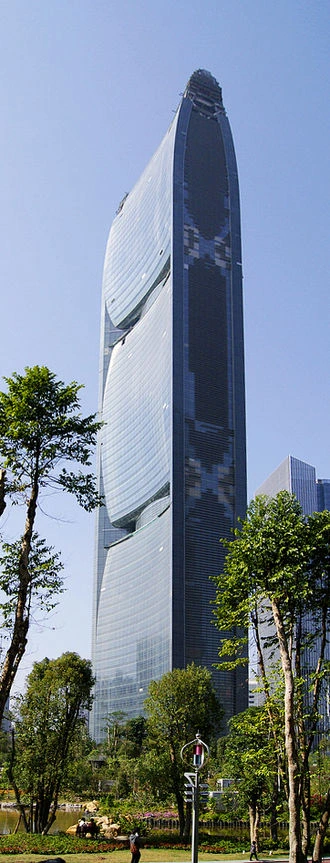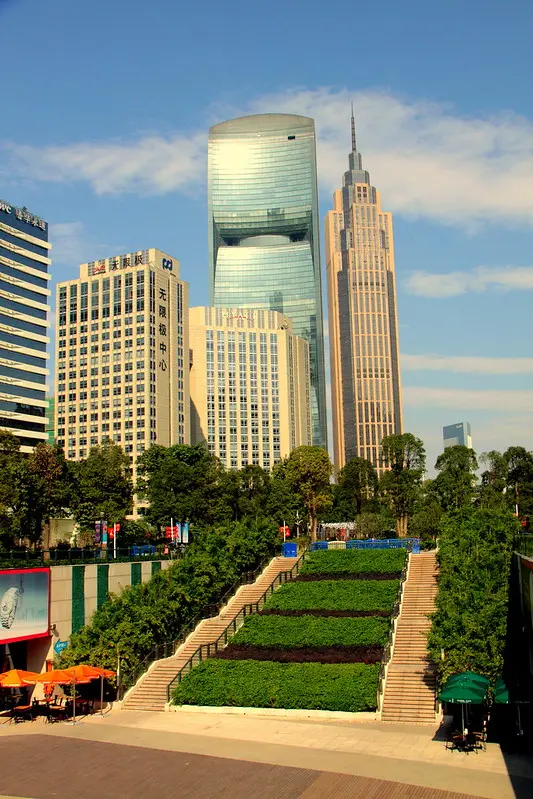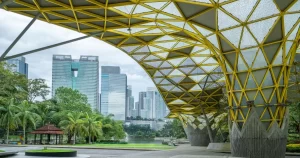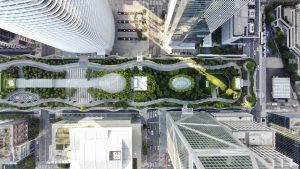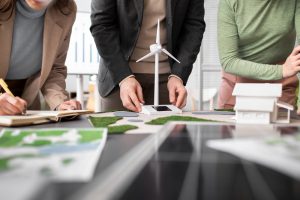Sustainable Architecture: How to lead the way for pioneering Eco-buildings
By Mz Chaker & EAGC │May 01, 2025
Discover how Sustainable Architecture drives eco-friendly innovation. Learn key strategies to design pioneering, energy-efficient buildings for a greener future

In a world confronting climate change, dwindling resources, and rapid urbanization, Sustainable Architecture stands at the crossroads of hope and necessity. Modern cities demand innovation, but innovation alone is not enough. Buildings accounted for 34% of global energy demand and 37% of energy and process-related CO₂ emissions as of 2022 (UNEP & GlobalABC, 2023). If we are to protect our planet, we must redesign the spaces we inhabit. This isn’t just about reducing footprints—it’s about reimagining the entire blueprint. So, what makes a building truly sustainable? And how can architects become champions of this change?
This article dives deep into the heart of Sustainable Architecture. What does it mean in practice? How do materials, design, and technology work together to shape resilient, energy-efficient buildings? We’ll explore real-world examples, break down core principles, and uncover the challenges and rewards of designing for a greener future. Get ready to discover how you can lead the way.
1. Foundations of Sustainable Architecture
Transitioning into the world of green building design means revisiting the roots and redefining the future. Let’s begin with the essence of sustainability and how it took shape over time.
Defining Sustainability in Building Design
At its core, sustainable architecture seeks to meet today’s needs without sacrificing tomorrow’s possibilities. It’s a mindful approach that considers the full lifecycle of a building—from design to demolition. Importantly, it aims to reduce the environmental impact while enhancing functionality and comfort. This involves optimizing energy use, conserving resources, and prioritizing occupant health. In short, Green Buildings reflect a deep respect for nature and future generations.
Historical Perspectives
Historically, architecture was naturally rooted in sustainability. Ancient civilizations skillfully used what they had on hand—local materials like adobe, stone, bamboo, and timber. They designed buildings to suit their climates, incorporating passive design strategies such as thick walls for insulation, courtyards for ventilation, and thoughtful orientation for optimal sunlight. These practices minimized environmental impact while maximizing comfort.
However, with the onset of industrialization, priorities shifted toward mass production and quick construction. This change sidelined environmentally conscious methods in favor of speed and profit. Yet today, a growing environmental awareness is driving a revival of these age-old techniques. Architects are learning from the past and integrating it with cutting-edge innovations—like smart glazing, renewable energy systems, and modern insulation technologies. As a result, a new generation of sustainable cities is emerging—ones that blend heritage, climate responsiveness, and technology into smart, livable environments.
2. Core Principles Guiding Eco-Buildings
Now that we’ve explored the roots, let’s delve into the principles shaping eco-friendly buildings today. From energy use to air quality, these elements define the framework of sustainable architecture.
Energy Efficiency
Energy conservation is one of the primary goals of green building design. Passive solar design takes advantage of the sun’s path to reduce heating needs. Proper insulation helps retain warmth in winter and keep interiors cool in summer. Natural ventilation, such as cross-breezes and thermal chimneys, reduces the demand for air conditioning. Meanwhile, daylighting strategies—like skylights and south-facing windows—cut down on artificial lighting. These techniques create buildings that work with nature, not against it.
In tandem with passive methods, active systems also play a key role. Building automation systems (BAS) help monitor and optimize energy use. Smart thermostats adjust heating and cooling based on occupancy. LED lighting, energy-efficient appliances, and motion-sensor systems further reduce waste. These tools make it easier to track performance and fine-tune building behavior in real time.
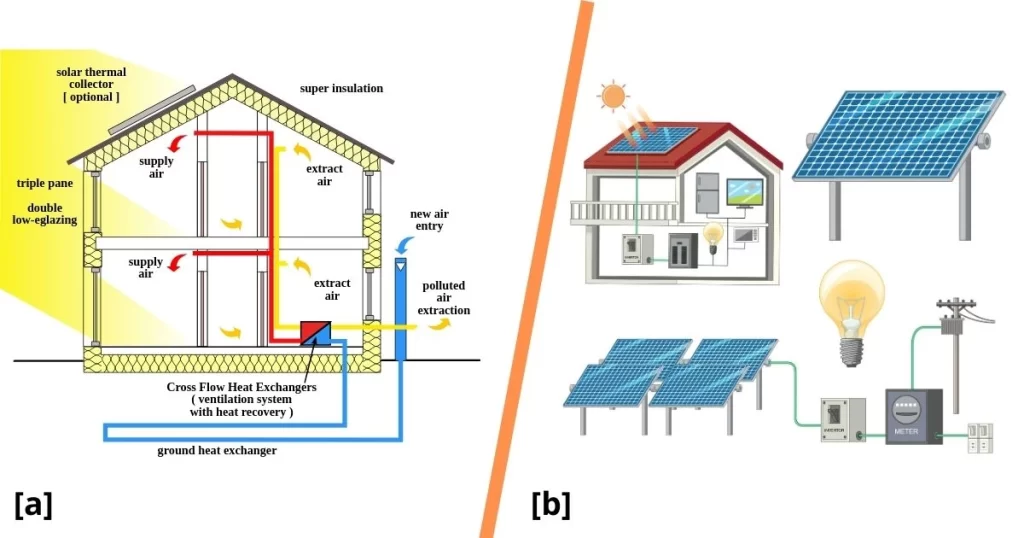
[a] Passive solar design By @Passivhaus_section_en.jpg: Passivhaus Institutderivative work: Michka B (talk) – Passivhaus_section_en.jpg, CC BY-SA 3.0, via Wikimedia Commons
[b] Active solar design By @ Freepik
Material Selection
The materials used in construction have a lasting impact; hence, choosing sustainable options begins with mindful sourcing and a commitment to environmental responsibility. Key strategies to achieve this include:
- Sourcing materials locally reduces transportation emissions and supports regional economies
- Using recycled and reclaimed materials, such as reclaimed wood or recycled steel, to conserve natural resources
- Selecting low-impact, renewable materials—like bamboo and cork—that grow quickly and replenish naturally
All these choices contribute to a lower carbon footprint. Alongside this, innovative materials are also transforming the landscape of sustainable construction. For instance, Hempcrete, made from hemp fibers and lime, is lightweight, insulating, and carbon-negative, meaning it absorbs more carbon than it emits during its lifecycle. Similarly, cross-laminated timber (CLT) combines the strength of steel with the renewability of wood, offering a compelling alternative for structural elements in buildings.
These innovations signal a shift in our thinking about durability, efficiency, and responsibility.
Water Conservation
Water is another precious resource; thus, sustainable buildings adopt strategies that minimize waste. For instance, rainwater harvesting collects runoff for landscaping or flushing toilets. Greywater recycling treats wastewater from sinks and showers for reuse. As a result, these systems reduce dependence on municipal water while lowering utility bills. Moreover, further water savings come from smart design choices, including:
- Low-flow toilets, faucets, and showerheads significantly cut daily water consumption without sacrificing performance.
- Smart irrigation systems use weather data to minimize unnecessary watering and prevent overuse.
Together, these elements create a closed-loop water system that supports Sustainability and enhances building performance and resilience.
Indoor Environmental Quality
A building’s internal environment significantly supports both health and productivity. Above all, ventilation is key to ensuring a continuous supply of fresh air. That can be achieved through:
- Natural airflow, which allows spaces to breathe without mechanical intervention,
- Mechanical ventilation systems regulate and refresh indoor air, especially in dense or sealed environments.
In addition, using non-toxic paints, adhesives, and flooring materials helps reduce occupants’ exposure to harmful chemicals. Consequently, these strategies greatly enhance indoor air quality and support long-term well-being.
Lighting is equally significant. In particular, daylight reduces the need for artificial lighting but also enhances occupants’ mood, concentration, and overall cognitive function. So, to maximize natural light, green buildings often feature:
- Strategically placed windows that capture sunlight throughout the day,
- Reflective surfaces to amplify illumination, and
- Light wells that direct sunlight into deeper areas of the interior.
These thoughtful design elements create a brighter, healthier indoor environment where people can truly thrive—both physically and mentally.
3. Innovative Design Strategies
True Sustainable Architecture requires creativity. Innovative approaches push the boundaries of what’s possible. Let’s look at how cutting-edge strategies are redefining eco-design.
Biophilic Design
Biophilic design strengthens the vital connection between humans and nature. Incorporating natural elements into architectural spaces creates environments that feel alive and nurturing. For instance, Green walls, Indoor plants, and Water features seamlessly introduce nature into interior settings.
That not only enriches the visual appeal but also reduces stress while improving indoor air quality and promoting a greater sense of well-being. Ultimately, this approach transforms buildings into healthier, more inviting spaces—places where people can feel more grounded, focused, and connected.
Modular and Prefabricated Construction
Modular designs significantly streamline the building process, offering both speed and precision. In particular, the components’ prefabrication accurs off-site, reducing material wastage and shortening overall construction time. Additionally, this method allows better quality control since each element takes place in a controlled environment.
As a result, modular construction supports a more efficient and sustainable approach by enabling faster project completion, cleaner construction sites, and more consistent building performance. These advantages make modular methods an ideal solution for meeting the growing demands of sustainable cities, where time, efficiency, and environmental impact are key considerations.
Adaptive Reuse
Instead of demolishing, why not repurpose? In this context, adaptive reuse transforms old structures for new functions. This strategy preserves cultural heritage and reduces the need for new construction materials. For example, adaptive reuse projects can include:
- Converting old factories into modern apartment complexes,
- Repurposing churches as vibrant community libraries, and
- Renovating warehouses into creative office spaces.
Ultimately, this approach delivers a win-win scenario—honoring historical significance while minimizing environmental impact. It exemplifies how architecture can bridge the past and the future in a meaningful and sustainable way.
4. Case Studies: Leading Examples of Sustainable Architecture
In addition to The Edge of Amsterdam and The Bullitt Center of Seattle, the buildings listed below set global standards in innovation and impact.
Pearl River Tower, Guangzhou
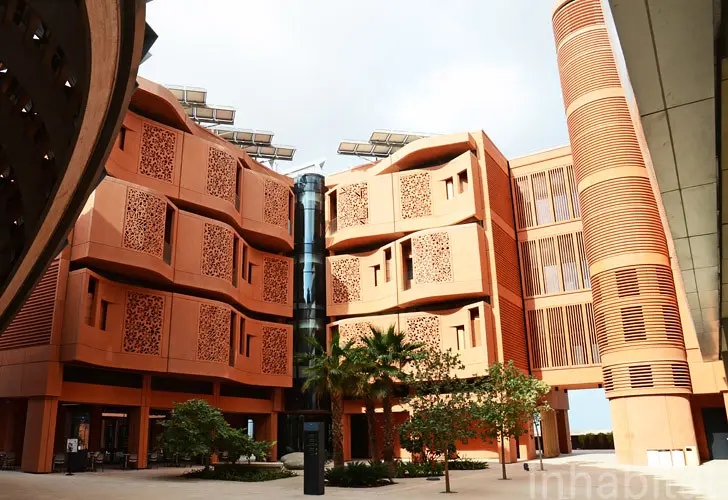
By @ Inhabitat on Flickr.com
Masdar City , Abu Dhabi
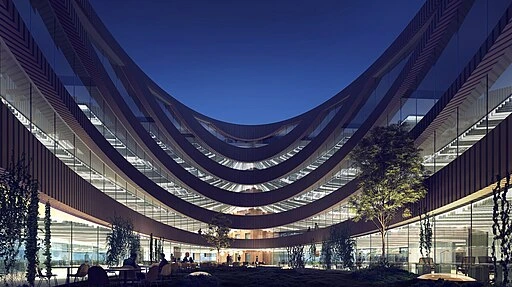
By @Lyndsayclose, CC BY-SA 4.0, via Wikimedia Commons
Powerhouse Brattørkaia, Norway
Pearl River Tower, Guangzhou
This skyscraper seamlessly integrates wind turbines and solar panels to generate its energy. Moreover, it is designed with aerodynamics, significantly reducing wind resistance and overall energy use. In In sum, it showcases several innovative features, such as:
- Wind turbines embedded within the structure,
- High-performance solar panels on the façade and rooftop, and
- A streamlined form that optimizes natural airflow.
Ultimately, it proves that even tall buildings, often seen as energy-intensive, can become highly energy-efficient when sustainability is a design priority.
Masdar City, Abu Dhabi
Similarly, Masdar City stands as a bold experiment in Sustainable Urban Planning. Designed to function as a zero-carbon, zero-waste city powered entirely by Renewable Energy, it implements several strategic measures:
- Narrow streets and carefully oriented buildings maximize shade and promote natural cooling,
- Extensive solar panels and innovative wind towers significantly reduce the need for air conditioning,
- Public transport systems and walkable neighborhoods encourage low-carbon mobility.
Therefore, Masdar City offers valuable insights into the future of eco-conscious urban living, particularly in extreme desert climates where sustainability poses unique challenges.
Powerhouse Brattørkaia, Norway
Similarly, Powerhouse Brattørkaia pushes boundaries in energy-positive architecture by demonstrating groundbreaking innovations:
- The building generates more energy over its lifetime than it consumes, setting a new standard for sustainable architecture,
- Solar panels combined with smart energy management systems efficiently cover all operational needs, ensuring minimal reliance on external energy sources,
- High insulation levels and passive design strategies considerably minimize energy loss and maintain interior comfort.
As a result, Powerhouse Brattørkaia proves that buildings can indeed be climate-positive, even in challenging cold northern environments.
5. Challenges and Solutions in Sustainable Design
While the vision is inspiring, challenges remain. Let’s explore the barriers—and how to overcome them.
Budget Constraints
Sustainable buildings often require higher upfront investments; however, they also offer significant long-term benefits that we shouldn’t overlook. In particular, they provide:
- Lower operating costs through reduced energy and water consumption,
- Long-term savings on maintenance and utility expenses,
- Increased property value due to growing market demand for Green building design.
Moreover, various financial tools help make these projects more accessible. For instance, incentives and rebates offered by governments and organizations can offset initial costs. Additionally, conducting a thorough life cycle cost analysis helps decision-makers understand the full economic value over time rather than focusing solely on short-term expenditures.
Technical Limitations
Sometimes, sustainable solutions face technical hurdles, like poor material availability or lack of trained labor. Nevertheless, continuous innovations in materials and construction techniques are helping to bridge these gaps effectively. Likewise, advances such as cross-laminated timber, hempcrete, and modular construction open new doors for scalable, energy-efficient design.
6. The Role of Policy and Certification
Policies and standards shape the adoption of green buildings. Let’s look at how certification and government action move the industry forward.
Green Building Certifications
Certifications like LEED, BREEAM, and WELL set measurable benchmarks for Sustainable Architecture. They not only encourage adherence to high environmental standards, but they also provide a consistent evaluation framework. Moreover, these certifications serve multiple purposes:
- They guide architects and developers toward recognized best practices,
- They offer credibility and transparency to eco-projects,
- They also help communicate a building’s sustainability performance to stakeholders and occupants.
Together, such systems drive broader industry adoption and elevate the quality of green design worldwide.
Government Initiatives
Public policy plays an influential role in shaping the future of green development. Government interventions can accelerate the adoption of sustainable methods across the construction industry. For example:
- Tax incentives reward developers who integrate renewable energy systems,
- Grants support research, pilot projects, and innovative green technologies,
- Green building codes establish minimum performance standards and compliance expectations.
As a result, these supportive policies are not only powerful tools for reducing emissions and conserving resources. Still, they are also vital for scaling systemic change across cities and nations.
7. The Future of Sustainable Architecture
Looking ahead, we find new promise and potential. Let’s explore what the future holds.
Emerging Trends
Future trends in sustainable architecture are rapidly reshaping the way we design and build. As innovation gains momentum, it brings a wave of transformative technologies. For example, some of the most promising developments include:
- 3D-printed buildings, which reduce construction waste and speed up project timelines,
- Carbon-negative materials, such as hempcrete and algae-based composites, absorb more carbon than they emit,
- AI-driven design enables architects to optimize energy efficiency and resource use through predictive modeling.
As these advancements become more accessible and widely adopted, sustainability will no longer be a particular feature. Instead, it will become the standard—an essential foundation rather than an optional pattern.
Educating the Next Generation
To build a better future, we must first teach it. Therefore, education plays a crucial role in shaping the mindset of future designers and builders. Schools and universities, notably, are responsible for embedding sustainable architecture into their curricula. In doing so, they ensure that the next generation of professionals gains the knowledge and values they need to tackle environmental challenges. Key educational goals should include:
- A deep understanding of eco-friendly materials and building methods,
- Proficiency in energy modeling and sustainable design tools,
- Awareness of environmental regulations and certifications,
- And, most importantly, a commitment to long-term environmental stewardship.
Ultimately, the architects of tomorrow must be fluent in eco-thinking, not only as a skill but as a foundational design philosophy.
In conclusion,
Sustainable Architecture is not just a trend—it is a powerful movement that redefines how we build, live, and connect with the environment. By embracing smart design, innovative materials, renewable energy, and forward-thinking policies, we can create beautiful spaces that are functional and environmentally responsible.
Throughout this article, we explored the foundations and guiding principles of green building. In particular, we examined real-world case studies that showcase the potential of eco-architecture in action. Moreover, we looked at how technology and regulation are reshaping construction methods. Looking forward, it is clear that sustainability, energy efficiency, and carbon-conscious design will soon become the global standard.
So, how do we lead the way for pioneering eco-buildings? We do so by rethinking outdated practices and embedding environmental responsibility into every design and construction phase. Additionally, we must promote a culture of innovation, invest in education, support green policies, and collaborate across industries to achieve long-lasting impact.
The path ahead is clear—and filled with opportunity. Sustainable Architecture is no longer optional; it’s a shared mission for everyone shaping our built world. It’s our chance to redesign cities, reconnect with nature, and construct a healthier, more resilient future. Let’s not wait for change—let’s lead it. One eco-building at a time.
Leave a Comment

